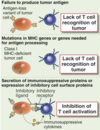Week 6 lec - tumours Flashcards
(72 cards)
The concept of immune surveillance of cancer, which was proposed by Macfarlane Burnet in the 1950s, states that?
a physiologic function of the immune system is to recognize and destroy clones of transformed cells before they grow into tumors and to kill tumors after they are formed

what are the three possible outcomes of premalignant lesions?
escape - the immune system cannot fight it and it becomes a primary tumour and metastasises
equilibrium - the immune system can control the growth of the lesion but can’t remove it
elimination - immune system destroys premalignant cells

how does the immune system recognise tumours?
the express certain Ags
this picture seems really important, make some flashcards based on it when you actually understand what’s going on

what are the 3 key concepts in tumour immunity?
- tumours express Ags which the host immune system recognises as foreign
- immune response often fails to prevent tumour growth
- the immune system can be activated by external input to eradicate tumours
what is the mononuclear cell infiltrate that many tumours are surrounded by composed of?
T lymphocytes, natural killer (NK) cells, and macrophages
what types of cells are present in lymph nodes draining the sites of tumour growth?
activated lymphocytes and macrophages
does the presence of lymphocytic infiltrates in some types of melanoma and carcinomas of the colon and breast predict a better or worse prognosis?
better
immunoscore measures the density of what T lymphocyte populations in the core or periphery of tumours?
CD3, CD8 and CD45RO
what has a better prognosis, an immunoscore of 0 or of 4?
4
what chemokines in a tumour site are associated with survival?
CX3CL1, CXCL9, CXCL10, CCL5 and CCl2
what cytotoxic factors in a tumour site are associated with survival?
the usual lads - granzymes, perforin and granulysin
what Th1 cell-associated factors in a tumour site are associated with survival?
IFNy, IL-12, T-bet and IRF1
what effect would you expect finding Th17, Treg and Th2 cells in a tumour site to have on survival?
variable effect depending on tumour type
what effect would TLS have on survival?
the presence and quality has a positive association with survival
what is the principal mechanism of adaptive immune protection against tumors?
killing of tumor cells by CD8 + CTLs
how do CTLs recognise tumours?
by tumour Ag peptides which are presented on MHC1 molecules
prognosis which particular type of tumour is more favorable when more CTLs are present within the tumor?
colonic carcinomas
what does TIL stand for?
tumour-infiltrating lymphocyte
TILs extracted from human solid tumours contain CTLs with the capacity to do what?
kill the tumour from which they were extracted
a recent clinical trial has demonstrated that ? can lead to the development of strong T cell responses against the tumor?
blocking these inhibitory pathways, and thus removing the brakes on immune responses
NK cells kill many types of tumour cells, especially those that have what?
reduced class I MHC expression and express ligands for NK cell–activating receptors
In vitro, can NK cells kill virally infected cells?
yes
In vitro, what type of tumour is especially vulnerable to NK cells?
hematopoietic tumors













